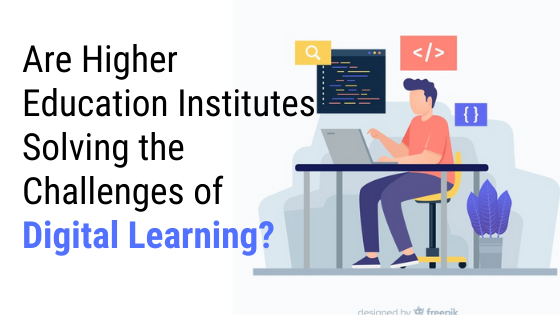Are Higher Education Institutes Solving the Challenges of Digital Learning?
Digital Learning is the future. It is expected to grow to $325 Billion by 2025. With the growing Internet penetration in India, digital learning ecosystem is gaining momentum.
Digital learning includes adaptive learning, blended learning, e-books, mobile learning, online learning, MOOCs etc. These are provided through various digital platforms. Higher education institutes have a very important role in creating an enabling environment for successful implementation and adoption of digital learning tools a and techniques.
Digital learning has completely democratized education. Through its widespread tools, education is now becoming accessible and affordable to students who do not have the financial resources to access it. Not only students but also their new generation parents are now been exposed to its advantages. They can now readily access information related to their wards career through educational apps and portals. Various digital applications and websites are enriching students with latest information and helping in the teaching learning process.
Expansion of digital learning education industry is offering big scope for students to improve grades and upskill. Digital tools that enable this are based on latest technology.
MOOC platforms, courser, study.com, udemy.com and discoverahobby.com along with host of others are providing video tutorials to aid self-learning. Although, there is a long way to tread before realizing the actual potential of Digital Education in India but even after lots of advantages, there are some prominent hurdles in providing education through digital techniques.
Digital Literacy & lack of appropriate Infrastructure are biggest challenges faced by institutions willing to implement digital learning. The majority of our population still does not have access to Internet or the required internet bandwidth while many others are illiterate in the digital revolution.
Higher education is costly. However with the help of digital learning tools, institutions of higher learning have great opportunity to expand their outreach and explore new market segments. They can reach out students who do not have the financial resources or other infrastructure facilities to pursue higher education courses.
Statistics indicate the global online education market is expected to touch more than $130 billion in the next few years. With more and more private players coming into the market, competition to attract potential students is increasing. This is also shrinking enrolments in some colleges. To combat this pressure, higher education institutions can launch innovative online courses. Although, a few colleges and universities have started offering online programs, but they are not taking enough steps to create a sustainable supply chain for themselves. Moreover, such programs are not receiving the desired focus they should get. However, this could change if colleges and universities start taking proactive steps to solve the challenges of digital learning.
Strategies and Solutions to Build Robust Digital Learning Practices by Higher Education Institutes
Most important strategy to deliver superior digital learning experience is by building a strong online presence. Next, identify committed people and resources for implementing marketing strategies to promote digital courses. Create adequate infrastructure for uninterrupted delivery of such programs. Secondly, you can also look for collaborators who can help your college design online programmes.
But regardless of the model chosen, it’s important to remember that merely creating a repository of videos and quiz based assignments won’t take you too far. For digital learning to become successful, it should be treated as another strategic business unit of your college or university. Digital learning must be engaging, need based and interesting. It should be a blend of traditional and digital tools.
The opportunities associated with digital learning are immense. The most significant benefit of digital learning tools is its ability to deliver personalize learning. Customized curriculum can be designed to fill the skill deficits of aspirants. Digital education tools can make it possible for institutions to develop education materials for each student.
One biggest advantage of digital learning is that it is powered by data analytics which can help monitor progress of each student. Teachers no longer would need to re-invent the wheel for each activity. If higher education institutes to solve the challenges of digital learning they must ensure that their students have access to the best possible educational environment.
Digital Education is a positive intervention. Digital revolution has paved the way for colleges and universities to introduce some breakthrough models in education. The Indian education sector has recently seen lot of radical changes. Digital learning is the solution to sections of the society that are deprived of accessibility and affordability.
In India, where mobile penetration is increasing day by day along with internet connections, the potential to digitally educate the masses does not seem a distant reality. Virtual classrooms are being set up by many institutions to aid the teaching learning process. With evolution of technologies such as cloud and artificial intelligence, there is huge potential for the education industry to foster digital learning.
By implementing digital learning technologies, institutes can bring bigger talent pool in the class. Students also feel that digital learning gives them greater flexibility to learn at their own pace and convenience. Teachers too find it an effective way to engage students through this medium.



